The resin cement for luting market exhibits a steady upward trend, expanding from USD 414.2 million in 2025 to USD 748.9 million by 2035 at a CAGR of 6.1%. The market demonstrates predictable peaks and troughs, largely influenced by product adoption cycles, dental procedure volumes, and regional healthcare investment patterns. Initial peaks occur in 2025–2026 as demand rises in developed regions with well-established dental care infrastructure. High awareness of advanced restorative and adhesive procedures drives early market highs, particularly in North America and Europe, where adoption of resin-based luting cements is robust.
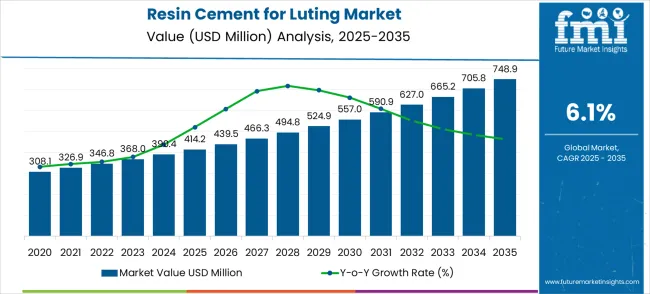
Subsequent troughs are observed in 2027–2028 due to slower adoption in emerging markets and regional economic fluctuations, which temporarily moderate growth. From 2028 to 2032, the market recovers and reaches new peaks as awareness campaigns, increasing dental procedure volumes, and the expansion of private dental clinics stimulate demand. Technological advancements in cement formulations, including enhanced bonding strength, reduced solubility, and improved handling properties, contribute to a renewed growth momentum.
Between 2032 and 2035, the market is expected to maintain a steady upward trajectory, reflecting widespread adoption and incremental penetration in emerging regions. The peak-to-trough pattern highlights a resilient market where temporary slowdowns are offset by innovation, regional expansion, and growing procedural volumes, allowing manufacturers to plan production, marketing, and supply strategies effectively.
| Metric | Value |
|---|---|
| Estimated Value in (2025E) | USD 414.2 million |
| Forecast Value in (2035F) | USD 748.9 million |
| Forecast CAGR (2025 to 2035) | 6.1% |
The resin cement for luting market is segmented into restorative dentistry at 40%, orthodontic bonding at 24%, prosthetic applications at 19%, root canal post cementation at 10%, and specialized dental treatments at 7%. Recent trends include self-adhesive and dual-cure formulations for faster application and stronger bonding. Manufacturers are developing flowable, color-stable, and bioactive resin cements to meet clinical and aesthetic needs. Integration with digital dentistry systems and CAD/CAM prosthetics enhances precision in restorations. Advancements in light-curing equipment and nanotechnology-based formulations improve handling, adhesion, and durability. Restorative dentistry leads adoption as clinicians rely on durable, tooth-colored cements for fillings, veneers, and inlays.
Orthodontic procedures use resin cements to secure brackets and appliances, while prosthetic applications require them for crowns and bridges to ensure long-term stability and patient satisfaction. Root canal post cementation supports endodontic treatments, and specialized applications include pediatric and cosmetic procedures. Market growth is driven by rising dental awareness, demand for aesthetic solutions, and continuous advancements in adhesive technologies.
The resin cement for luting market represents a high-growth segment in the dental materials industry, driven by increasing demand for aesthetic dentistry, advancements in digital workflows, and rising global investment in healthcare infrastructure. With the market expanding from USD 414.2 million in 2025 to USD 748.9 million by 2035 at a robust 6.1% CAGR, strategic opportunities emerge through advanced formulation development, digital dentistry integration, and geographic expansion in emerging healthcare markets. Hospital applications commanding USD 151.2 million in 2025, light-curing technology dominance, and China's exceptional 8.2% growth rate reflect the critical role of reliable bonding materials in modern restorative dentistry and prosthetic procedures.
The convergence of aesthetic patient expectations, digital restoration technologies, and bioactive material innovations creates multiple value creation pathways. Light-curing systems' market leadership demonstrates practitioners' preference for controlled polymerization and extended working times, while expanding applications across complex prosthetic procedures signal growing clinical sophistication and treatment complexity.
Market expansion is being supported by the increasing global demand for advanced dental restorative treatments and the corresponding need for reliable bonding materials that can provide durable adhesion while maintaining aesthetic properties across various indirect restoration applications. Modern dental practitioners are increasingly focused on implementing cementation solutions that can ensure long-term restoration retention, minimize post-operative sensitivity, and provide consistent bonding performance across different substrate materials. Resin cement for luting's proven ability to deliver superior bond strength, enhanced aesthetics, and versatile application compatibility make it an essential material for contemporary restorative dentistry and prosthetic procedures.
The growing priorty on aesthetic dentistry and patient satisfaction is driving demand for resin cements that can support natural-looking restorations, provide reliable long-term performance, and enable minimally invasive treatment approaches without compromising clinical outcomes. Dental professionals' preference for materials that combine superior bonding properties with ease of use and predictable results is creating opportunities for innovative cement formulations. The rising influence of digital dentistry and precision restoration techniques is also contributing to increased adoption of resin cements that can provide accurate fit and reliable bonding for computer-aided restorations.
The resin cement for luting market is projected to grow steadily due to increasing demand for reliable dental adhesive materials. Light-curing resin cement dominates the curing type segment with approximately 45% of the market share, offering polymerization within 20–40 seconds under LED light with bond strengths up to 30–35 MPa. Hospitals lead the application segment with about 40% of the market, reflecting the high volume of restorative and prosthodontic procedures performed in clinical settings.
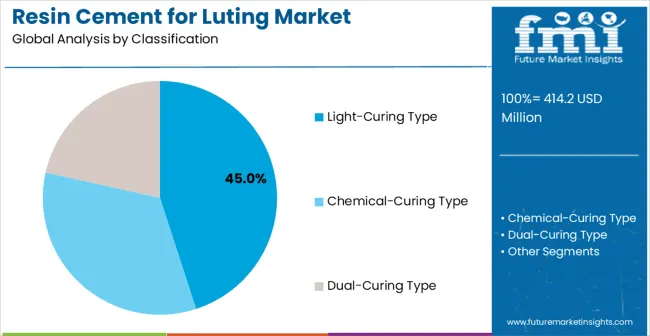
Light-curing resin cement holds approximately 45% of the curing type market, providing rapid polymerization under LED or halogen light, typically within 20–40 seconds. Bond strength ranges from 30–35 MPa, while polymerization shrinkage remains below 2%, ensuring stable adhesion for veneers, crowns, and inlays. Key manufacturers include 3M ESPE, Ivoclar Vivadent, GC Corporation, and Kuraray Noritake. The cement’s predictable setting and high mechanical properties allow dentists to complete procedures efficiently, reducing chair time by up to 20% compared to dual-cure alternatives. Its widespread adoption is driven by consistent performance in over 90% of routine clinical cases.
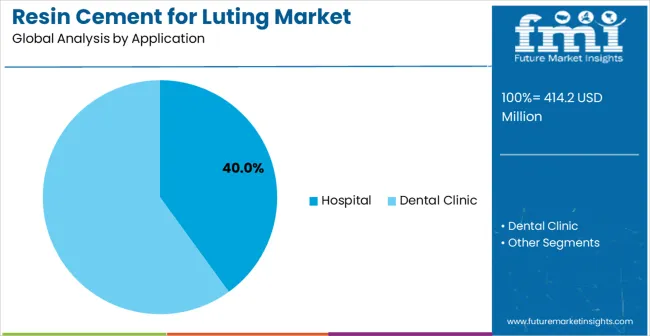
Hospitals account for approximately 40% of the application market, reflecting the largest share for resin cement usage. They perform an estimated 5–7 million restorative and prosthodontic procedures annually per large hospital network, relying on resin cements with compressive strengths above 300 MPa and adhesion reliability over 95%. Leading suppliers include 3M ESPE, Ivoclar Vivadent, GC Corporation, and Kuraray Noritake. Growth is fueled by increasing patient volumes, the expansion of hospital dental departments, and the need for minimally invasive restorative solutions where precise, strong, and durable luting materials are required.
The resin cement for luting market is advancing steadily due to increasing demand for aesthetic dental treatments and growing adoption of advanced bonding technologies that provide enhanced retention and durability for indirect restorations across diverse dental applications. The market faces challenges, including technique sensitivity requiring proper clinical protocols, competition from alternative cementation materials, and the need for continuous product innovation to meet evolving clinical requirements. Innovation in adhesive chemistry and bioactive formulations continues to influence product development and market expansion patterns.
The growing adoption of digital dentistry workflows and computer-aided restoration techniques is driving demand for resin cements that can provide a precise fit and reliable bonding for digitally manufactured restorations, including CAD/CAM crowns, bridges, and veneers. Advanced digital integration enables improved treatment planning while allowing more efficient restoration delivery and enhanced patient satisfaction across various restorative procedures and treatment complexities. Manufacturers are increasingly recognizing the competitive advantages of digital compatibility for modern dental practice integration and workflow optimization.
Modern resin cement producers are incorporating bioactive components and smart material technologies to enhance clinical performance, provide therapeutic benefits, and ensure long-term restoration success for demanding dental applications. These technologies improve treatment outcomes while enabling new clinical possibilities, including remineralization support and bacterial resistance properties. Advanced material integration also allows practitioners to support enhanced patient care and treatment longevity beyond traditional cementation capabilities.
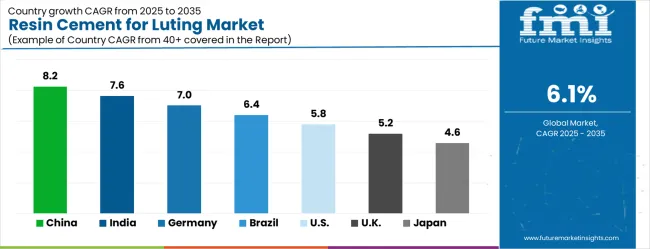
| Country | CAGR (2025-2035) |
|---|---|
| China | 8.2% |
| India | 7.6% |
| Germany | 7.0% |
| Brazil | 6.4% |
| USA | 5.8% |
| UK | 5.2% |
| Japan | 4.6% |
The resin cement for luting market is experiencing strong growth globally, with China leading at an 8.2% CAGR through 2035, driven by the expanding healthcare infrastructure, growing dental care awareness, and significant investment in modern dental technology adoption. India follows at 7.6%, supported by increasing healthcare accessibility, a growing middle-class population, and a rising emphasis on aesthetic dental treatments. Germany shows growth at 7.0%, priortizing on technological innovation and advanced dental material development. Brazil records 6.4%, focusing on healthcare infrastructure expansion and dental care accessibility improvement. The USA demonstrates 5.8% growth, driven by the established dental care market and advanced treatment adoption. The UK exhibits 5.2% growth, supported by healthcare system modernization and dental technology advancement. Japan shows 4.6% growth, priortizing on precision dental materials and advanced clinical applications.
The report covers an in-depth analysis of 40+ countries,Top-performing countries are highlighted below.
China records an 8.2% CAGR, well above the global 3.2%. Adoption is concentrated in Beijing, Shanghai, and Guangdong, primarily in advanced dental chains and high-volume prosthodontic laboratories. High demand for zirconia and ceramic crown restorations drives sales of dual-cured and light-cured resin cements. Suppliers such as 3M, GC Corporation, and Ivoclar Vivadent focus long working times, high bond strength, and color stability for aesthetic restorations. Digital dental workflows, including intraoral scanners and CAD/CAM integration, are applied in 30% of clinics. Training programs for adhesive techniques and advanced restorative procedures have expanded clinician adoption rates. Cosmetic dentistry awareness among patients supports consistent market growth.
India shows a 7.6% CAGR, above the global average. Maharashtra, Karnataka, and Delhi contribute 48% of installations, primarily in private clinics and cosmetic dentistry centers. Growth is fueled by rising popularity of indirect restorations such as inlays, onlays, and veneers. Suppliers like 3M, Ivoclar Vivadent, and Kuraray focus on self-adhesive cements with simplified handling for semi-skilled operators. Pre-measured capsule systems have gained adoption in urban clinics to improve consistency. Expansion of dental material distributors in tier-2 cities has increased accessibility by 20%. Demand for aesthetic procedures in anterior restorations is increasing, supporting higher sales volumes.
Germany records a 7.0% CAGR, above global 3.2%. Berlin, Hamburg, and Munich account for 52% of installations, concentrated in prosthodontic labs and high-end dental clinics. Low-shrinkage, high-bond-strength resin cements are preferred for ceramic and zirconia restorations. Suppliers like Ivoclar Vivadent, 3M, and Heraeus Kulzer provide temperature-stable materials for lab-fabricated units. Clinics using intraoral scanning for precise adhesive application represent 32% of total adoption. Continuing education in adhesive protocols supports 30% of new users. High-precision and minimally invasive procedures in urban labs are increasing adoption of dual-cured materials.
Brazil grows at a 6.4% CAGR. São Paulo, Rio de Janeiro, and Minas Gerais contribute 50% of installations. Private dental clinics and prosthodontic labs lead adoption, with suppliers such as 3M, GC Corporation, and Dentsply Sirona providing extended shelf-life and capsule-based products. Demand is driven by anterior aesthetic restorations and growing dental tourism in urban areas. Clinics using dual-cured cements for metal-ceramic restorations account for 28% of installations. Training in adhesive techniques for cosmetic procedures covers 20% of practitioners. Seasonal peaks in cosmetic treatments influence 22% of market activity.
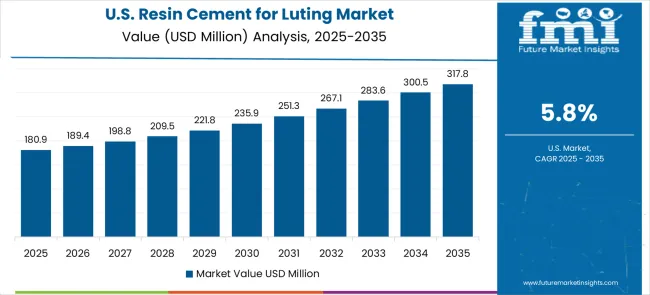
The USA grows at 5.8% CAGR. California, New York, and Texas account for 55% of installations. Cosmetic dentistry and prosthodontic specialty clinics drive high adoption of dual-cured and self-adhesive cements. Suppliers like 3M, Ivoclar Vivadent, and Kerr priortize on improved handling and color stability. Clinics integrating automated mixing and pre-dosed capsules account for 28% of installations. Workflow digitization in large urban clinics supports precise adhesive application. Patient preference for long-lasting and aesthetic restorations fuels consistent demand.
The UK records a 5.2% CAGR. London, Manchester, and Birmingham account for 50% of installations, concentrated in cosmetic dentistry and aesthetic restorative practices. Suppliers like Ivoclar Vivadent, 3M, and GC Corporation focus on dual-cured and color-matched cements. Clinics specializing in ceramic veneers represent 35% of adoption. Ongoing professional training in adhesive protocols reaches 25% of practitioners. Pre-measured capsules for time-efficient procedures are applied in 28% of installations, reducing preparation errors and standardizing results.
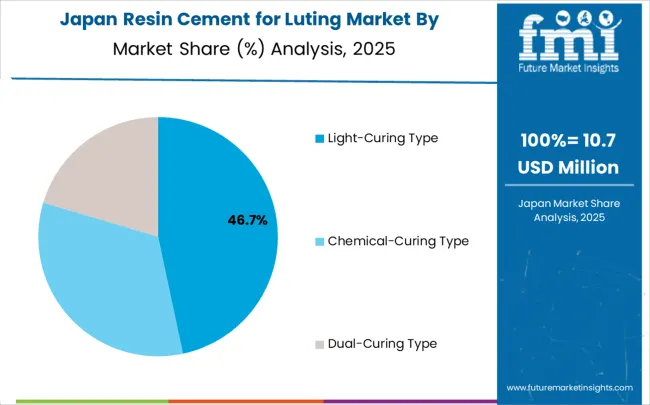
Japan exhibits a 4.6% CAGR, equal to the global average. Tokyo, Osaka, and Kyoto account for 50% of installations, primarily in high-precision dental clinics and prosthodontic labs. Suppliers such as GC Corporation, 3M, and Kuraray provide dual-cured and color-stable cements for zirconia and ceramic restorations. Pre-measured capsules for efficiency are applied in 28% of clinics. Clinics integrating CAD/CAM workflows represent 25% of installations. Minimally invasive adhesive techniques in anterior restorations drive 20% of usage. Limited expansion in new dental infrastructure compared with China and India constrains faster growth.
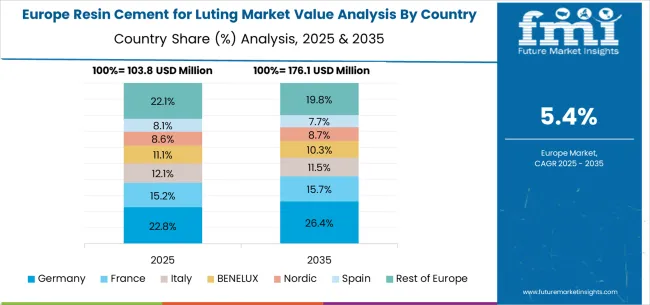
The resin cement for luting market in Europe is projected to grow from USD 96.2 million in 2025 to USD 174.0 million by 2035, registering a CAGR of 6.1% over the forecast period. Germany is expected to maintain its leadership position with a 30.4% market share in 2025, moderating slightly to 30.1% by 2035, supported by its strong dental industry, advanced material science capabilities, and comprehensive healthcare infrastructure serving major European markets.
The United Kingdom follows with a 24.1% share in 2025, projected to reach 24.3% by 2035, driven by a robust healthcare system infrastructure, established dental care standards, and strong demand for advanced dental materials across the NHS and private dental sectors. France holds a 19.2% share in 2025, rising to 19.4% by 2035, supported by healthcare modernization programs and increasing adoption of aesthetic dental treatments in clinical practice. Italy records 11.8% in 2025, inching to 11.9% by 2035, with growth underpinned by healthcare infrastructure improvement and increasing focus on advanced dental care delivery. Spain contributes 8.3% in 2025, moving to 8.4% by 2035, supported by expanding healthcare access and dental technology adoption programs. The Netherlands maintains a 2.9% share in 2025, growing to 3.0% by 2035. The Rest of Europe region, including Nordic countries, Eastern Europe, Belgium, Switzerland, and Austria, is anticipated to gain momentum, expanding its collective share from 3.3% to 2.9% by 2035, attributed to increasing adoption of advanced dental materials in Nordic countries and growing dental care activities across Eastern European markets implementing healthcare modernization programs.
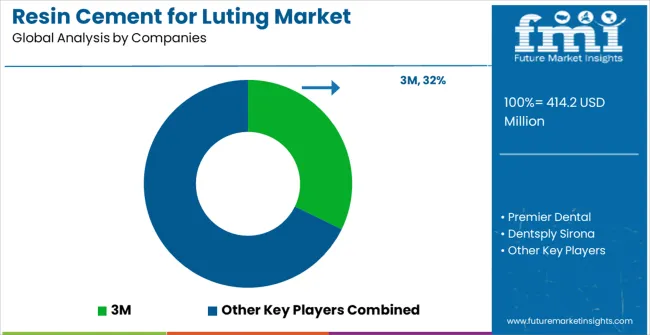
The resin cement for luting market is characterized by competition among established dental material manufacturers, specialized dental adhesive companies, and integrated oral care solution providers. Companies are investing in advanced adhesive chemistry research, clinical performance validation, biocompatibility enhancement, and comprehensive product portfolios to deliver consistent, high-performance, and safe dental bonding solutions. Innovation in polymerization systems, bioactive components, and ease-of-use features is central to strengthening market position and competitive advantage.
3M leads the market with a strong market share, offering comprehensive dental material solutions with a focus on adhesive technology innovation and clinical performance validation. Premier Dental provides specialized dental products with an focus on restorative materials and clinical education support. Dentsply Sirona delivers integrated dental solutions with a focus on comprehensive treatment workflows and material compatibility. Cosmedent specializes in aesthetic dental materials with emphasis on clinical excellence and practitioner education. Kulzer GmbH focuses on advanced dental materials and digital dentistry integration. Ivoclar Vivadent offers comprehensive restorative solutions with priortize on aesthetic outcomes and clinical reliability.
| Items | Values |
|---|---|
| Quantitative Units (2025) | USD 414.2 million |
| Curing Type | Light-Curing Type, Chemical-Curing Type, Dual-Curing Type |
| Application | Hospital, Dental Clinic |
| Regions Covered | North America, Europe, East Asia, South Asia & Pacific, Latin America, Middle East & Africa |
| Countries Covered | United States, Canada, United Kingdom, Germany, France, China, Japan, South Korea, India, Brazil, Australia and 40+ countries |
| Key Companies Profiled | 3M, Premier Dental, Dentsply Sirona, Cosmedent, Kulzer GmbH, and Ivoclar Vivadent |
| Additional Attributes | Dollar sales by curing type and application category, regional demand trends, competitive landscape, technological advancements in adhesive chemistry, bioactive formulation innovation, digital dentistry integration, and clinical performance optimization |
The global resin cement for luting market is estimated to be valued at USD 414.2 million in 2025.
The market size for the resin cement for luting market is projected to reach USD 748.9 million by 2035.
The resin cement for luting market is expected to grow at a 6.1% CAGR between 2025 and 2035.
The key product types in resin cement for luting market are light-curing type, chemical-curing type and dual-curing type.
In terms of application, hospital segment to command 40.0% share in the resin cement for luting market in 2025.






Our Research Products

The "Full Research Suite" delivers actionable market intel, deep dives on markets or technologies, so clients act faster, cut risk, and unlock growth.

The Leaderboard benchmarks and ranks top vendors, classifying them as Established Leaders, Leading Challengers, or Disruptors & Challengers.

Locates where complements amplify value and substitutes erode it, forecasting net impact by horizon

We deliver granular, decision-grade intel: market sizing, 5-year forecasts, pricing, adoption, usage, revenue, and operational KPIs—plus competitor tracking, regulation, and value chains—across 60 countries broadly.

Spot the shifts before they hit your P&L. We track inflection points, adoption curves, pricing moves, and ecosystem plays to show where demand is heading, why it is changing, and what to do next across high-growth markets and disruptive tech

Real-time reads of user behavior. We track shifting priorities, perceptions of today’s and next-gen services, and provider experience, then pace how fast tech moves from trial to adoption, blending buyer, consumer, and channel inputs with social signals (#WhySwitch, #UX).

Partner with our analyst team to build a custom report designed around your business priorities. From analysing market trends to assessing competitors or crafting bespoke datasets, we tailor insights to your needs.
Supplier Intelligence
Discovery & Profiling
Capacity & Footprint
Performance & Risk
Compliance & Governance
Commercial Readiness
Who Supplies Whom
Scorecards & Shortlists
Playbooks & Docs
Category Intelligence
Definition & Scope
Demand & Use Cases
Cost Drivers
Market Structure
Supply Chain Map
Trade & Policy
Operating Norms
Deliverables
Buyer Intelligence
Account Basics
Spend & Scope
Procurement Model
Vendor Requirements
Terms & Policies
Entry Strategy
Pain Points & Triggers
Outputs
Pricing Analysis
Benchmarks
Trends
Should-Cost
Indexation
Landed Cost
Commercial Terms
Deliverables
Brand Analysis
Positioning & Value Prop
Share & Presence
Customer Evidence
Go-to-Market
Digital & Reputation
Compliance & Trust
KPIs & Gaps
Outputs
Full Research Suite comprises of:
Market outlook & trends analysis
Interviews & case studies
Strategic recommendations
Vendor profiles & capabilities analysis
5-year forecasts
8 regions and 60+ country-level data splits
Market segment data splits
12 months of continuous data updates
DELIVERED AS:
PDF EXCEL ONLINE
Resin Silencer Market Size and Share Forecast Outlook 2025 to 2035
Resin Capsule Market Forecast and Outlook 2025 to 2035
Resin Pigments Market Size and Share Forecast Outlook 2025 to 2035
PE Resins Market Size and Share Forecast Outlook 2025 to 2035
Ink Resin Market Size and Share Forecast Outlook 2025 to 2035
Agar Resin Market
Cast Resin Transformer Market Size and Share Forecast Outlook 2025 to 2035
Epoxy Resin Industry Analysis in Asia Pacific Size and Share Forecast Outlook 2025 to 2035
Furan Resin Market Size and Share Forecast Outlook 2025 to 2035
Amino Resin Market Growth - Trends & Forecast 2025 to 2035
Epoxy Resin Market Growth – Trends & Forecast 2024-2034
Cobalt Resinate Market Size and Share Forecast Outlook 2025 to 2035
Compact Resin Type Silencer Market Size and Share Forecast Outlook 2025 to 2035
Acrylic Resin Market Size and Share Forecast Outlook 2025 to 2035
Barrier Resins Market Size and Share Forecast Outlook 2025 to 2035
Coating Resins Market Size and Share Forecast Outlook 2025 to 2035
Plastic Resins Market Size, Share & Forecast 2025 to 2035
Phenolic Resins Market Size and Share Forecast Outlook 2025 to 2035
Composite Resin Market Size and Share Forecast Outlook 2025 to 2035
Iodinated Resins Market Analysis - Size, Share, and Forecast Outlook 2025 to 2035

Thank you!
You will receive an email from our Business Development Manager. Please be sure to check your SPAM/JUNK folder too.
Chat With
MaRIA